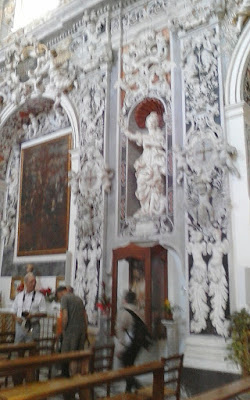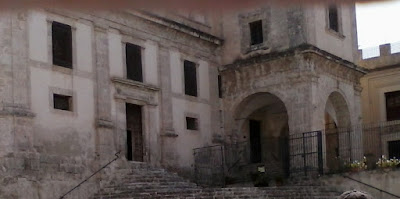OK, let's try to catch up.
Last Spring I received an email from the art director of a national magazine - Bridal Guide - asking about my bridal banners. She asked for me to send her a particular one. They were going to photograph it for their Fall issue. I was thrilled to pieces. I packed up the banner and sent it off.
 |
| It's hard to see, I know - but the brides are each holding the ends of one of my banners |
I had visions of selling millions of bridal banners because of the exposure in a national magazine and began to furiously collect more vintage doilies. Then I gave up on that tack and began to purchase new doilies. Vintage doilies are a labor intensive proposition. I reasoned that banners made with new doilies looked just as pretty as the ones made with vintage doilies and I could make them at less cost, therefore, charge less for them. The ones made with new doilies don't have the enchanting history and heirloom quality of the vintage lace ones, though. But I was in a crunch with no time to hunt down local estate sales, compete against antique dealers for the linens, launder them and prepare them for transformation into a wedding accessory.
 |
| All handmade vintage rectangular doilies banner |
I made a bunch of the ones with vintage doilies before developing the new plan (B). On these antique doily banners, each doily is unique, created by a different individual, different hands, different crochet hooks, different parts of the country, different time frames..................... I suspect they were mostly created around the 1900's to the 1940's. At that point in time, there was no polyurethaned (case goods) furniture, no plastic coatings whatsoever, no fake/faux wood. Wood was wood. It wasn't plastic. It came from a tree. It got transformed into furniture (beds, dressers, chests, tables, stands, pianos, chairs........................... It needed to be carefully cared for. You didn't eat on it for fear the dish or glass would sweat or drip and leave a mark on the wood surface. It was covered with something (linen tablecloth, lace tablecloth or doilies, etc.). The case goods (dressers/chests) were covered with lace or linen as well (doilies/scarves). These valuable pieces of furniture required protection from perfumes, lotions, even scratches, dents, etc.
The upholstered furniture was protected with doilies as well. There were no "miracle fabrics". Upholstery was wool, silk or cotton - all natural fibers. The housewives protected the headrests and arms of their upholstery with..............what else? doilies. You could easily launder the doily. Not so, the sofa.
Doilies are outdated, passe', unnecessary today. Sadly, I suspect there are many of them in landfills. . But these pieces of vintage needlework art have captured my heart. I just can't get enough of them. And they seem to be the perfect romantic vehicle for a wedding, especially a vintage, Boho or barn wedding.
Alas, my big dream of being inundated with orders for wedding banners has not materialized as yet. But whenever it does, I'm ready.
~~~~~~~~~~~~~~~~~~~~~~~~~~~~~~~~~~~~~~~~~~~~~~~~~~~~~~~~~~~~~~~~~~~~~~~~~~~









































